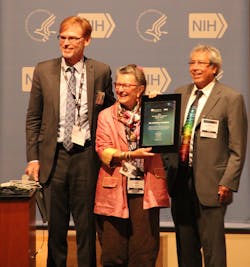Translational Research: Bench-to-bedside: Progress, pioneers, and 21st Century Cures

The NIH/SPIE Biophotonics from Bench to Bedside workshop (Sept. 24-25) featured speakers and posters presenting exciting translational research in technologies and applications. A follow-up to the 7th inter-institute workshop held in 2011, the event aimed to celebrate the International Year of Light, and present developments and challenges faced by those working at the forefront of light in medicine.
It drew more than 200 attendees to National Institutes of Health (NIH) headquarters in Bethesda, MD, and focused on six main technology and application areas: the brain, global health innovation, optical coherence tomography (OCT), cancer, image-guided therapy/surgery, and advanced optical microscopy. A final panel discussion highlighted funding and the future.
Of the four keynotes, three featured recipients of SPIE's Britton Chance Biomedical Optics Award: Robert Alfano of the City College of New York spoke about light advances in biomedicine; Lihong Wang of Washington University in St. Louis presented on photoacoustic tomography, wavefront engineering, and compressed ultrafast photography; and 2016 winner David Boas of the Athinoula A. Martinos Center for Biomedical Imaging (Charlestown, MA) discussed functional near-infrared (NIR) spectroscopy. Jim Fujimoto of MIT (Cambridge, MA) reviewed OCT development and applications.
During the event, Katarina Svanberg of Lund University (Sweden) was presented with the 2015 NIH Bench-to-Bedside Pioneer Award in recognition of her significant contributions to the field of oncology using photodynamic therapy, and for transferring spectroscopic biomedical techniques to work in developing countries (see figure).
Recent passage of the 21st Century Cures Act (H.R. 6) in the U.S. House of Representatives (the Act remains in the Senate as of this writing) boosted the mood at the workshop. In his welcome address, event co-chair Bruce Tromberg of Beckman Laser Institute and Medical Clinic (other chairs were Amir Gandjbakhche of NIH and Israel Gannot of Johns Hopkins and Tel Aviv Universities) quoted a 21st Century Cures Subcommittee in noting that the legislation's purpose is to "… help bring more cures and treatments to patients and strengthen the innovation ecosystem in the United States..." For more on 21st Century Cures and its implications for biomedical optics, see "Legislation promises biophotonics opportunities."

Barbara Gefvert | Editor-in-Chief, BioOptics World (2008-2020)
Barbara G. Gefvert has been a science and technology editor and writer since 1987, and served as editor in chief on multiple publications, including Sensors magazine for nearly a decade.